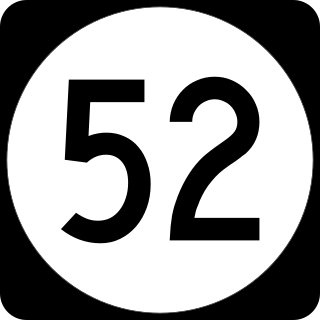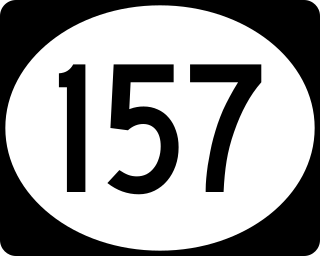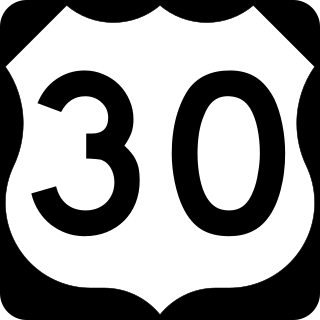Ocean Highway | |
|---|---|
| Route information | |
| Existed | 1909–1916 |
| Major junctions | |
| South end | Cape May |
| North end | Atlantic Highlands |
| Location | |
| Country | United States |
| State | New Jersey |
| Highway system | |
Ocean Highway was a state highway in the U.S. state of New Jersey. Legislated in 1909 as Ocean Boulevard, it was New Jersey's first state highway. Amending legislation in 1910 changed the designation to Ocean Highway. [1]
This route, and the Delaware River Drive predated any highway numbering system in New Jersey, and may be considered a transition between the early auto trails and modern state highways.
It is not related to Ocean Drive.
The Ocean Highway was to run from Atlantic Highlands to Cape May. The 1910 Annual Report of the New Jersey Commissioner of Public Roads refers to the funding of several projects specifically to be included in the route:
From the above and later projects, this route followed Ocean Boulevard through Atlantic Highlands to Navesink Avenue in Highlands. From there it followed Ocean Avenue south through Monmouth County along the Atlantic Ocean. Though the commission didn't outline the way through Monmouth County south of Deal, a popular route outlined by the Automobile Blue Book passed through Allenhurst via Corlies Avenue and Norwood Avenue, continuing to Asbury Park on Park Avenue, Sunset Avenue, Grand Avenue, and Cookman Avenue. Another route outlined in the book continued south from Asbury Park on Main Street, heading straight through Spring Lake on Third Avenue, East Lake Avenue, and 1st Avenue, returning to modern-day Route 71 by Washington Avenue in Sea Girt. The highway then continued south along Route 71 (barring a small realignment around Parker Avenue and Stockton Lake Boulevard), then accessed the Point Pleasant Bridge by Union Lane, Evergreen Avenue, Riverview Drive, and Higgins Avenue. The Ocean Highway then crossed into Ocean County via the present Route 35, though it diverged from this route to access Point Pleasant more directly by way of River Ave and Arnold Avenue. The route continued into Lakewood via the present Route 88, then roughly followed U.S. Route 9 and Route 109 to Cape May. Major divergences from this route include Route 166, accessing Toms River; a roadway connecting to a now-demolished bridge across the Mullica River, partly replaced by Route 167; and the Shore Road in Atlantic County, which U.S. 9 has bypassed and is now partly serviced by Route 157.A short spur from Seaville to Petersburg in Upper Township is now part of Route 50.[ citation needed ] Because the bridge across the Great Egg Harbor had yet to be built, motorists could either go through Ocean City, or travel east along this spur, up Route 50 to Egg Harbor City, and east to Absecon along the White Horse Pike.
The Ocean Highway was first authorized in 1909 and was New Jersey's first state highway. [1] It was reauthorized in 1910, and it was under that legislation that any appropriations were made, and that any construction was to take place. [3] The earliest improvements listed by the state highway commission include the section from Cape May to the Cape May Courthouse in 1901. This improved section was later extended to Beesley's Point in 1913, completing the route in Cape May County. By this time, the sections in Atlantic County and Ocean County to Tom's River had already been completed, and the commission expressed a desire to connect the sections in Atlantic and Cape May counties with a bridge; this would later be accomplished by the Beesley's Point Bridge. Other completed alignments included a stretch of Ocean Avenue in Sea Bright and the road connecting to Atlantic Highlands now known as Ocean Boulevard.
In 1916, legislation was passed authorizing the extension of the Ocean Highway west from Atlantic Highlands to Matawan Creek, [4] but it is unlikely that this was ever acted upon, as later that year (The Egan Bill) legislation was passed establishing a system of numbered state highways that replaced the Ocean Highway with a section of Route 36 west of Sea Bright and Route 4 to its south, which took a more inland route through Monmouth County and extended only as far south as Absecon. [5] From Somers to Beesleys Point, a ferry connected the two points, as the Beesley's Point Bridge wouldn't be constructed until 1927. [6] The 1917 Edge Bill created Route 14, which followed the old Ocean Highway route from Seaville to Cape May, as well as the Petersburg Spur. [7]

Route 18 is a 42.8-mile-long (68.9 km) state highway in the central part of the US state of New Jersey. It begins at an intersection with Route 138 in Wall Township, Monmouth County and ends at Interstate 287 (I-287) in Piscataway Township, Middlesex County. Route 18 is a major route through central New Jersey that connects the Jersey Shore to the Raritan Valley region, connecting the county seats of Monmouth (Freehold) and Middlesex respectively. The route runs through Ocean Township, Marlboro Township, East Brunswick, and is the main thoroughfare for Rutgers University. Much of the route is a freeway. The remainder of the route is an arterial road with traffic lights in the East Brunswick and Old Bridge areas, and a boulevard in the remainder of Piscataway. Route 18 was designated in 1939 as a proposed freeway from Old Bridge to Eatontown. The section west of Old Bridge was formerly designated as part Route S28, a prefixed spur of State Highway Route 28 from Middlesex to Matawan. The designation, assigned in the 1927 renumbering, remained until a second renumbering in 1953. At that point, Route S28 was redesignated as Route 18, though the section from Old Bridge to Matawan was signed as TEMP 18, as this section would be decommissioned when the Route 18 freeway was built.

Route 35 is a state highway in the U.S. state of New Jersey, primarily traveling through the easternmost parts of Middlesex, Monmouth, and Ocean counties. It runs 58.11 mi (93.52 km) from the entrance to Island Beach State Park in Berkeley Township, Ocean County to an intersection with Route 27 in Rahway, Union County. Between Seaside Park and Mantoloking, Route 35 follows the right-of-way of the former Pennsylvania Railroad along the Jersey Shore. The route heads through Point Pleasant Beach and crosses the Manasquan River on the Brielle Bridge, meeting Route 34 and Route 70 at the former Brielle Circle in Wall Township. From there, Route 35 heads north and intersects Route 138, an extension of Interstate 195, continuing north through Monmouth County before crossing the Victory Bridge over the Raritan River into Perth Amboy, where the route continues north to Rahway.

U.S. Route 9 (US 9) is a north–south United States Numbered Highway in the states of Delaware, New Jersey, and New York in the Northeastern United States. It is one of only two U.S. Highways with a ferry connection ; the other is US 10. US 9 is signed east–west in Delaware and north–south on the rest of its route. The southern terminus of the route is in Laurel, Delaware, at an intersection with US 13, while the highway's northern terminus is at a junction with Interstate 87 (I-87) in Champlain, New York, where the old roadway continues north as the unsigned New York State Route 971B (NY 971B), which ends in a cul-de-sac just short of the Canadian border.

Atlantic County is a county located along the Jersey Shore in the U.S. state of New Jersey. As of the 2020 census, the county was the state's 15th-most-populous county, with a population of 274,534, a drop of 15 from the 2010 census count of 274,549. Its county seat is the Mays Landing section of Hamilton Township. The county is part of the South Jersey region of the state.

Route 4 is an east-west arterial road in Bergen County and Passaic County, New Jersey, United States. The highway stretches 10.83 mi (17.43 km) from Route 20 in Paterson east to an interchange with Interstate 95 (I-95), U.S. Route 1/9 (US 1/9), US 46, and US 9W at the George Washington Bridge approach in Fort Lee.

Route 36 is a state highway in Monmouth County, New Jersey, United States. The 24.40-mile (39.27 km) long route, shaped as a backwards C, begins at an intersection with the Garden State Parkway and County Route 51 on the border of Tinton Falls and Eatontown and runs east to Long Branch. From Long Branch, the route follows the Atlantic Ocean north to Sea Bright and turns west, running to the south of the Raritan Bay. Route 36 ends in Keyport at an interchange with the Garden State Parkway and Route 35. It varies in width from a six-lane divided highway to a two-lane undivided road. The route is signed east–west between Eatontown and Long Branch and north–south between Long Branch and Keyport.

Route 50 is a state highway in the southern part of the U.S. state of New Jersey. It runs 26.02 mi (41.88 km) from an intersection with U.S. Route 9 and the Garden State Parkway in Upper Township, Cape May County, north to an intersection with US 30 and County Route 563 in Egg Harbor City, Atlantic County. The route, which is mostly a two-lane undivided road, passes through mostly rural areas of Atlantic and Cape May counties as well as the communities of Tuckahoe, Corbin City, Estell Manor, and Mays Landing. Route 50 intersects several roads, including Route 49 in Tuckahoe, US 40 in Mays Landing, and US 322 and the Atlantic City Expressway in Hamilton Township.

Route 52 is a state highway in the southern part of the U.S. state of New Jersey. The highway runs 2.74 mi (4.41 km) from 9th Street in Ocean City, Cape May County north to U.S. Route 9 in Somers Point, Atlantic County. It is composed mostly of a series of four-lane divided bridges over Great Egg Harbor Bay from Ocean City to Somers Point known as the Howard S. Stainton Memorial Causeway, also known as the Ninth Street Bridge. The remainder of the route is a surface road called MacArthur Boulevard that runs from the causeway to U.S. Route 9. This section of the route formerly included the Somers Point Circle, now a traffic light, where Route 52 intersects County Route 559 and County Route 585.

Route 71 is a state highway in New Jersey that runs 16.78 miles (27.00 km) near the shore in Monmouth County. It begins at Route 35 in Brielle just north of the Manasquan River and the Ocean County line and heads north to Route 35 in Eatontown with a four block concurrency with Route 35 in Belmar. Monmouth University is located off Route 71 in West Long Branch.

Route 87 is a state highway located in Atlantic County in the U.S. state of New Jersey. It runs 1.70 mi (2.74 km), heading north from Atlantic City at an intersection with U.S. Route 30 to Brigantine, where it terminates at the end of the Brigantine Bridge over the Absecon Inlet, continuing as County Route 638. In Atlantic City, the route runs through the Marina District, which contains a few casinos, along Huron Avenue and Brigantine Boulevard. Here, Route 87 intersects with Route 187 and the Atlantic City–Brigantine Connector, the latter providing a limited-access route between Route 87 and the Atlantic City Expressway. Route 87 is the only road to and from Brigantine.

Route 109 is a 3.06-mile (4.92 km) state highway located in Cape May County, New Jersey, United States. The route runs from Jackson Street in Cape May north to an intersection with U.S. Route 9 in Lower Township. It crosses one of two road bridges over the Cape May Canal and provides access to the southern end of the Garden State Parkway and County Route 621 as well as to Cape May. Only the section of road in Lower Township is state maintained; the rest is maintained by Cape May County and signed as County Route 633, which extends 0.34 mi (0.55 km) past the southern terminus along Jackson Street and Perry Street to County Route 626 in West Cape May.

The Garden State Parkway (GSP) is a controlled-access toll road that stretches the north–south length of eastern New Jersey from the state's southernmost tip near Cape May north to the New York state line at Montvale. Its name refers to New Jersey's nickname, the "Garden State". The parkway has an unsigned reference number of Route 444 by the New Jersey Department of Transportation (NJDOT). At its north end, the road becomes the Garden State Parkway Connector, a component of the New York State Thruway system that connects to the Thruway mainline in Ramapo.

Route 147 is a 4.20-mile (6.76 km) state highway located in Cape May County in New Jersey, United States. It is a short connector between U.S. Route 9 in Middle Township and North Wildwood at New York Avenue. West of U.S. Route 9, the road continues to Route 47 as County Route 618 ; this route along with Route 147 provides an alternate route to The Wildwoods from Route 47. East of New York Avenue, the route continues south through The Wildwoods as County Route 621. The route passes through mostly marshland along its journey, intersecting the Garden State Parkway at a partial interchange and County Route 619.

Route 157 is a short state highway in the city of Absecon, New Jersey. The route runs for only 0.91 miles (1.46 km) as North Shore Road from an intersection with U.S. Route 30 (US 30), County Route 585 (CR 585) and Atlantic County Route 601 in the center of Absecon to an intersection with U.S. Route 9 in the northern portion of the city. The route is a former alignment of U.S. Route 9/State Highway Route 4 through Absecon, intersecting with State Highway Route 43 starting in the 1927 state highway renumbering. The route stayed on the alignment until 1930, when U.S. Route 9/Route 4 was bypassed to the west. The former alignment remained unnumbered until the 1953 state highway renumbering, when it was designated as Route 157.

County Route 549 is a county highway in the U.S. state of New Jersey. The highway extends 17.82 miles (28.68 km) from Main Street at County Route 527 in Toms River to County Route 547 at Monmouth CR 21 in Howell. The highway has the distinction of being the only 500-series route left with two separate spur routes.

U.S. Route 9 (US 9) is a United States Numbered Highway in the Mid-Atlantic region of the United States, running from Laurel, Delaware, to Champlain, New York. In New Jersey, the route runs 166.80 miles (268.44 km) from the Cape May–Lewes Ferry terminal in North Cape May, Cape May County, where the ferry carries US 9 across the Delaware Bay to Lewes, Delaware, north to the George Washington Bridge in Fort Lee, Bergen County, where the route along with Interstate 95 (I-95) and US 1 continue into New York City. US 9 is the longest U.S. Highway in the state.

U.S. Route 322 is a spur of U.S. Route 22, running from Cleveland, Ohio, east to Atlantic City, New Jersey. The easternmost segment of the route in New Jersey runs 62.64 miles (100.81 km) from the Commodore Barry Bridge over the Delaware River in Logan Township, Gloucester County, where it continues southeast to Atlantic Avenue and Pacific Avenue in Atlantic City, Atlantic County. The portion of the route between the Commodore Barry Bridge and Route 42 in Williamstown is mostly a two-lane undivided road that is concurrently signed with County Route 536 (CR 536), passing through Mullica Hill and Glassboro. From Williamstown, US 322 follows the Black Horse Pike, a four-lane road, southeast to Atlantic City. In Hamilton Township, Atlantic County, US 322 forms a concurrency with U.S. Route 40, continuing with that route all the way to Atlantic City. US 322 intersects several major roads including U.S. Route 130 and Interstate 295 (I-295) in Logan Township, the New Jersey Turnpike in Woolwich Township, Route 55 in Harrison Township, Route 42 in Williamstown, Route 50 and U.S. Route 40 in Hamilton Township, the Garden State Parkway in Egg Harbor Township, and U.S. Route 9 in Pleasantville.

U.S. Route 30 is a U.S. highway running from Astoria, Oregon east to Atlantic City, New Jersey. In the U.S. state of New Jersey, US 30 runs 58.26 miles (93.76 km) from the Benjamin Franklin Bridge at the Delaware River in Camden, Camden County, while concurrent with Interstate 676 (I-676), southeast to Virginia Avenue in Atlantic City, Atlantic County. Most of the route in New Jersey is known as the White Horse Pike and is four lanes wide. The road runs through mostly developed areas in Camden County, with surroundings becoming more rural as the road approaches Atlantic County. US 30 runs through several towns including Collingswood, Berlin, Hammonton, Egg Harbor City, and Absecon.

The Brigantine Bridge is a vehicular bridge over Absecon Inlet in Atlantic County, New Jersey. It is located just west of the Atlantic Ocean in Atlantic City and the resort community of Brigantine, providing the only road access to Brigantine Island. It is owned and operated by the New Jersey Department of Transportation (NJDOT). The bridge carries New Jersey Route 87, which then becomes County Route 638 at its northern end. At its southern end it connects with the Atlantic City–Brigantine Connector.